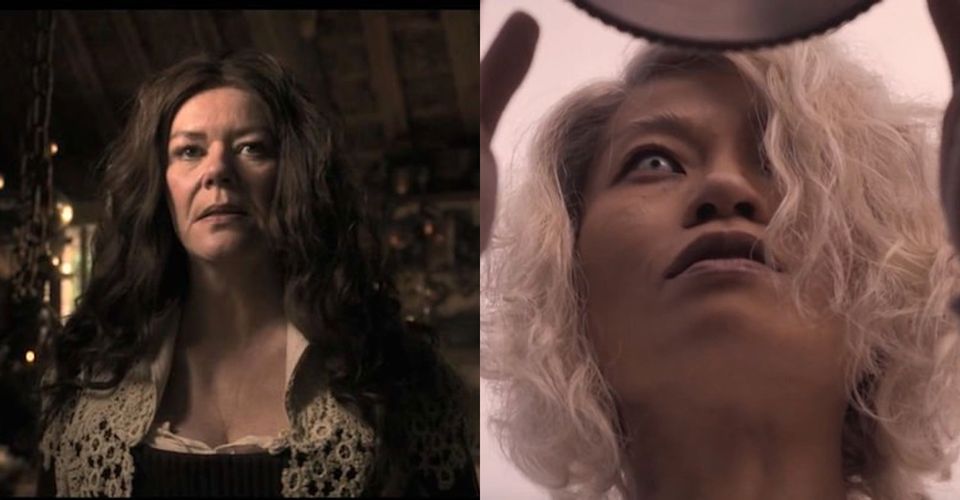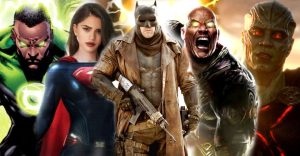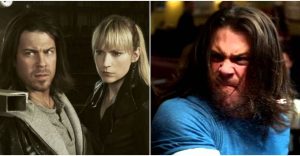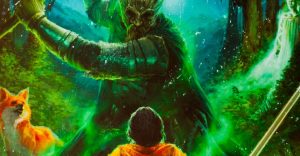Good Omens: 10 Best Side Characters

The first season of Good Omens was all about the incredible dynamic between Crowley and Aziraphale, and season two, which was recently announced, brings them back alongside a lost angel who will presumably kick off the plot. However, while the angel/demon duo stole the show, there were plenty of side characters in this packed cast that had a huge impact on the series as a whole.
Characters like Adam, Newt, Anathema, Beelzebub, Gabriel, Shadwell, and Tracy are generally considered to be major players, and even though supporting characters are generally seen as being in half of the episodes of a season or more, as a six-episode miniseries, this definition doesn’t apply here. Instead, some characters who are in every episode still feel like side characters based on their importance and overall screen time – but large or small, these roles are still memorable.
10 Agnes Nutter

Agnes Nutter, who wrote the only true book of prophecies in the world, only gets one major scene to herself – and she dies at the end of it. Nevertheless, it is she who guides Anathema through her book of prophecies, and who gets Aziraphale and Crowley through their trials with her well-timed advice. She’s got a way with words, and the audience is treated to some quite interesting quotes throughout the show as a result.
Agnes Nutter is probably the only Good Omens character (other than God) who truly thought ahead and planned things out; her prophecies, however, allowed her to do so. On the other hand, she has such a forceful personality that it seems like she guides her prophecies rather than the other way around. Despite being from the seventeenth century, Agnes seems out of her time, modernized due to her foreknowledge. Agnes still manages to make her mark despite being a side character, since her prophecies maneuver others into the places they need to be.
9 The International Expressman

The International Expressman, named Lesley, is an ordinary postman who has been asked to deliver the weapons of the Four Horsepersons of the Apocalypse. He is unfazed by the conditions he is asked to travel to – which includes peace talks that quickly turn into a war zone. Later, he turns up to take everything back and asks Aziraphale to sign for the return of the flaming sword. This is an element that was the same in the book.
His non-reaction to all the major magic around him is very British, and reminiscent of Monty Python since most people would be panicking. Lesley acts as an audience avatar for the viewers because he’s an ordinary human who isn’t connected to any of the supernatural elements except for his job. He is an example of the normality that Crowley and Aziraphale are clinging to and fighting for: the essence of humanity, essentially.
8 William Shakespeare

Crowley and Aziraphale run into William Shakespeare when they go to see a rehearsal of Hamlet at the Globe Theater. Though he’s only in one scene in episode three, he is a side character who makes a major impact on the two leads: he makes them realize that they’re friends.
He asks Aziraphale what his friend thinks of the play, and despite the fact that they deny that they are friends, this scene is also the first instance of the Arrangement that Crowley and Aziraphale devise to work more efficiently. The said arrangement eventually solidifies their friendship – and they have Shakespeare to thank for really kicking it off. Crowley and Aziraphale end up making sure Hamlet is popular, so it’s a win-win situation for everyone.
7 Warlock Dowling

Warlock Dowling is the child who Crowley and Aziraphale think is the Antichrist at the beginning of the season. As such, they spend the next 11 years with him, balancing out his ventures towards both good and evil to avert the apocalypse.
Warlock is an interesting look at an alternate idea of the Antichrist, who was influenced most of his life by supernatural entities beyond his control, unlike Adam. Most series’ don’t show an alternative version of a main character, but it makes Warlock a character to keep an eye on. Since the narrative leaves him only one episode in, it would be fun to see how he turned out after everything.
6 Hell’s Usher

The usher in Hell announces Aziraphale-as-Crowley’s trial. Later on, when the denizens of Hell need someone to test the holy water, they plop him in, and he dies while asking what he did to deserve it. Unfortunately, he is in the wrong place at the wrong time, Hastur tells him dispassionately.
He’s one of the only demons who isn’t human in appearance yet has a fairly prestigious position. Nevertheless, his death shows how easily Hell finds its own lieutenants disposable and serves as foreshadowing for Crowley’s own quick demise – even if it doesn’t actually come to pass.
5 Metatron

The Metatron is God’s spokesperson and interacts with Aziraphale when he is trying to get in touch with God. Metatron represents the bureaucracy of Heaven, as well as Aziraphale’s own misguided idea that if he just gets in touch with God, everything will work out. This doesn’t come to pass. Metatron, therefore, is interesting for being on the angelic side, but not actually doing anything to either help Aziraphale or stop the apocalypse. Metatron simply wants the war to start, because it is supposed to.
4 Pollution

Pollution doesn’t have a terribly large role in Good Omens (they took the role over from Pestilence after the invention of penicillin). However, Pollution’s casting really stands out, since they’re nonbinary and POC, as confirmed explicitly by Gaiman (all the angels, in fact, are non-binary). Pollution is also, due to the retirement, a completely new character for this version of Judeo-Christian mythology to poke fun at. They show up to the airbase with the rest of the Horsepersons and are dispatched by Brian. Pollution sees a dirty river as an ideal and is strangely beautiful in her extreme belief. This defines her character and helps her stand apart from the other Horsepersons.
3 Hastur

Hastur is a denizen of Hell who brings this series right back to comedy, particularly with his girly scream when Crowley kills Ligur with the holy water. He threatens Crowley on the M25, thinking that he won’t possibly try to go through the hellfire, but he does. Hastur’s own demise is due to underestimating Crowley, who he knows will do things no other demon would. Hastur’s earlier reaction to Crowley’s plan for the M25 shows how unimaginative the other demons are, and why he doesn’t want to work with them. Crowley wants to be on his own side on Earth, and Hastur exemplifies the opposite of that.
2 Michael

Like Aziraphale, the angel Michael has connections to Hell. She mainly stays behind Gabriel, but does participate in Aziraphale-as-Crowley’s death by holy water: she shows up after a while to take the water away, only to be surprised by the still alive Crowley.
She represents the duplicity of Heaven by her dealings with Hell; she doesn’t care about Earth the way Aziraphale does, but also doesn’t mind participating in something non-angelic (such as working with Hell) as long as it gets her what she wants. Gabriel is similar, and it’s therefore not surprising that they purposefully work together on Aziraphale and Crowley’s trials.
1 Mr. Young

Adam’s father is a prime example of a supporting character who has a large impact on the plot, both in the book and miniseries. In the last episode, Adam rewrites reality so that Mr. Young has always been his father, which completely changes the outcome of the apocalypse – namely, by ensuring it doesn’t happen. Mr. Young’s impact is therefore astronomical. He seems like a perfectly nice man, and a good father, and that’s why Adam rewrites reality in the first place. His adopting Adam and being there for him for the last 11 years allowed Adam to grow up human, and see the world for what it is: necessary and wonderful.
About The Author


















